fxguide last spoke to Moonbot Studios right before they had won the Academy Award for their short film The Fantastic Flying Books of Mr. Morris Lessmore. Their latest effort is The Scarecrow, co-directed by Brandon Oldenburg and Limbert Fabian, and an accompanying game app for Mexican-food chain Chipotle, with a chilling tale to tell about the state of food production.
We have an exclusive video behind the scenes of the film and we talk to several members of the Moonbot team, including Fabian, lead technical director Meg Deane, studio technical director Bohdon Sayre and pipeline techical director Brennan Chapman.
– Watch The Scarecrow.
fxg: With this project, it seems you were able to do something that was quite different to say a normal TVC or spot for a client. Can you talk about approaching it differently?
Limbert Fabian: Yeah, from the beginning when CAA approached us about the relationship between Moonbot and Chipotle, it was always intended that the final film would be a discussion starter. That the project would incite conversation. It would point to things going on in the real world. That was important to us as a studio that it was something a little bigger than just a brand.
fxg: What were some of your early discussions about how to actually achieve the film and the game?
Fabian: Early on, they were seeing what was happening with Morris Lessmore and the companion app for the film, which felt like it wasn’t just a re-hash of the film in any way. It was an expansion of the universe and the conversation in the film and about having fun in that world. So they were thinking to up the ante on what was happening with ‘Back to the Start’ – where they had blended animation with a great track. That’s where we came in with interactive apps and play. For us the challenge was what can we do that moves on from Morris, and we were immediately thinking: game. That it should feel like it was an arcade experience and more than just poking around and reading articles. We wanted to challenge the audience in an engaging way and have fun.

fxg: There seems to be a combination of techniques being used here – what were they?
Meg Deane: On Morris we had 2D backgrounds, then miniatures and CG animation. But you come up with a different pipeline for what’s needed. For Chipotle there are some shots that are fully CG, and then some where it’s a 2D background with a locked camera and then a 2D background with a moving camera. Then there’s the live action stuff which requires tracking.
Fabian: We tried to identify in the boarding phase what we’d need to do for each shot. We tried to get images or still frames that spoke to the look we were going for. We knew for a fact that just for aesthetic and creative reasons that the farm in some capacity would be a miniature because it needed to feel organic and hand-made, as a direct visual opposition to the crows and the world of the factory. We worked with an artist to sculpt a lot of miniature food. The barn and all the pieces inside the shop were all crafted out of pieces of balsa wood and styrofoam.
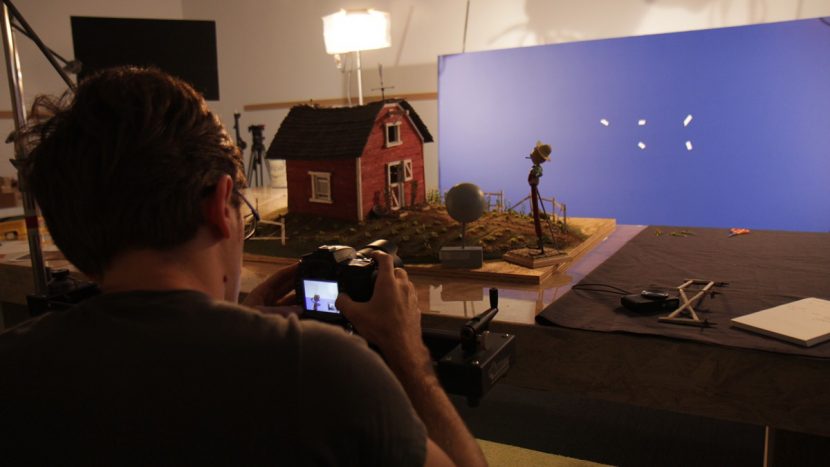
fxg: How were the miniatures filmed?
Bohdon Sayre: It was incredibly fun to shoot. We would all stay up late painting the houses and then the next day it was like, let’s do it. We had a guy come in to help us with lighting. The moves were fairly simple but more complex than some our previous makeshift rigs. We went to a local camera place and rented a track. We used a Nikon D7000. We had been testing a lot of cameras to get the right frame rate. We wanted to shoot as fast as we could and continuously because we didn’t have a control rig to move and fire. It was hand driven, which was really tough. So we wanted to shoot as fast as possible so that the air and the movement will be less noticeable.
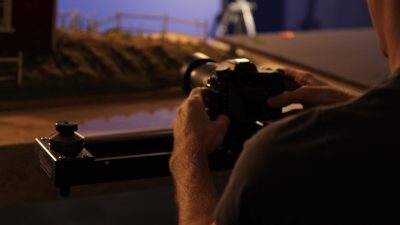
Fabian: There’s actually one shot that didn’t make it into the film which was actually a bit of a headache to capture. There was a pan shot of the scarecrow arriving at the farm and walking to his front door, that didn’t make the cut.
Sayre: We had to divide it up, knowing that we had to go 14 inches over how many seconds, divided by the frame rate of the camera. But the problem was we wanted to ease out of this move. So the way we were driving the camera was with a large dial – it was 5 or so inches, so you know that one rotation equals x amount of inches. So we made a guide using the camera move previs’d in Maya of the exact rotation the dial could do over the shot. So essentially we’d play back the shot while recording and in realtime just try to make sure the dial matches exactly what’s on screen.
Fabian: That was all done in the spirt of getting the shots done as quickly as possible just so we could play with the comps. We knew there were motion control systems out there that people use all the time, but we only needed to do it for two shots.
fxg: How did you approach planning what would be CG and what would be miniatures and 2D?
Deane: There was firstly a lot of boarding, and then before we got into modeling or texturing, our artists give us a ton of concept art and expression sheets. A lot of the shots also have matte paintings for the backgrounds which inform the lighting. It made the CG look better, I thought, as we had to match the illustrated world as opposed to making it all-CG.
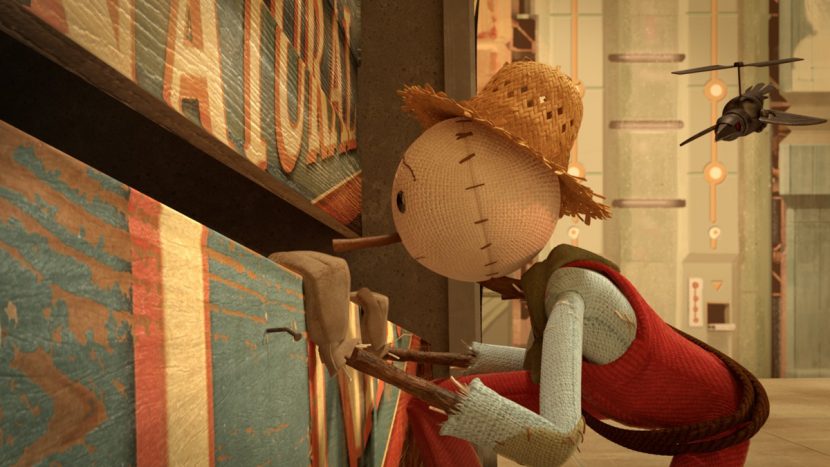
Fabian: We did a color script that we wanted to stick to pretty rigidly, but each matte painting kept evolving and in a lot of ways the CG helped drive the amount of detail we were putting into the matte paintings. The matte paintings set the tone for the film, but once the shots came back from lighting, we would go in and push some of the matte paintings.
fxg: Was there a particular animation, lighting and rendering setup?
Brennan Chapman: We have a custom rigging toolset called Butterfly that we rig all our characters in, plus props and assets in each scene in Maya. We pretty much live in Maya for the entire pipe until it goes to Nuke for compositing and Final Cut for editing. We’re using Mental Ray for rendering.
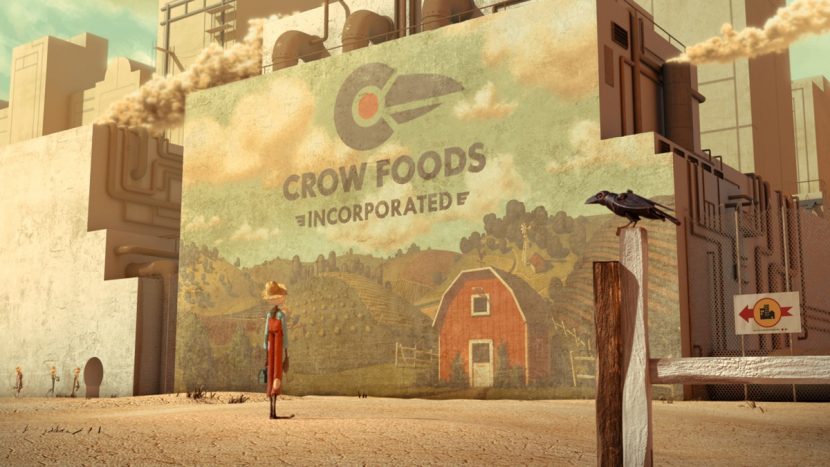
fxg: Can you tell me more about the rigging tools, Butterfly?
Chapman: Butterfly is a blueprint-based rigging system – so instead of rigging linearly, you set up Maya and tell it what to do when you actually rig it, and then you run your model through the rigging process and then it builds the rig from that. Thus, when you have revisions and you update the model and you do revisions on the inputs, then you can quickly come up with new rigs without having to start from square one every time you change something big.
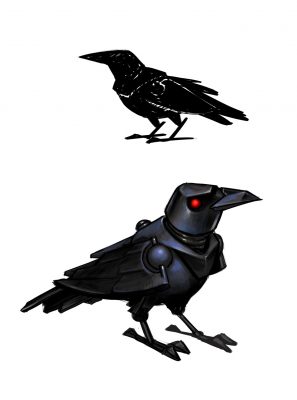
fxg: What were some of the effects requirements for the film?
Deane: The Scarecrow’s straw hat was a challenge, but it’s just a model of a hat that we had a few joints in. There are no sims on the actual scarecrow – just our animators. The dust you see after he gets off the train – that was shot live action as plates done during the Morris production. We created a huge library of dry ice and dust and paper particles. The smoke stacks were done as a fluid sim.
fxg: One thing that’s very apparent in the film are the transitions between scenes. Can you talk about designing those in?
Fabian: In the boarding phase I was really aware of trying to cram in as much as we could and getting us from place to place and making sure that jumps made sense. For a long time I was really opposed to any cuts in the film, so that was a mandate early on: to avoid traditional cuts and keep it organic and moving. I think it’s evolved from years of trying to tell stories in 30 second formats.
fxg: Then of course there’s the accompanying game app – were you able to re-purpose any models or assets for that?
Chapman: We used Unity to do the game development. The assets roughly transfered but in a lot of ways we had to re-create different kinds of assets. The Scarecrow is a completely different lower-res model to be able to work with games.
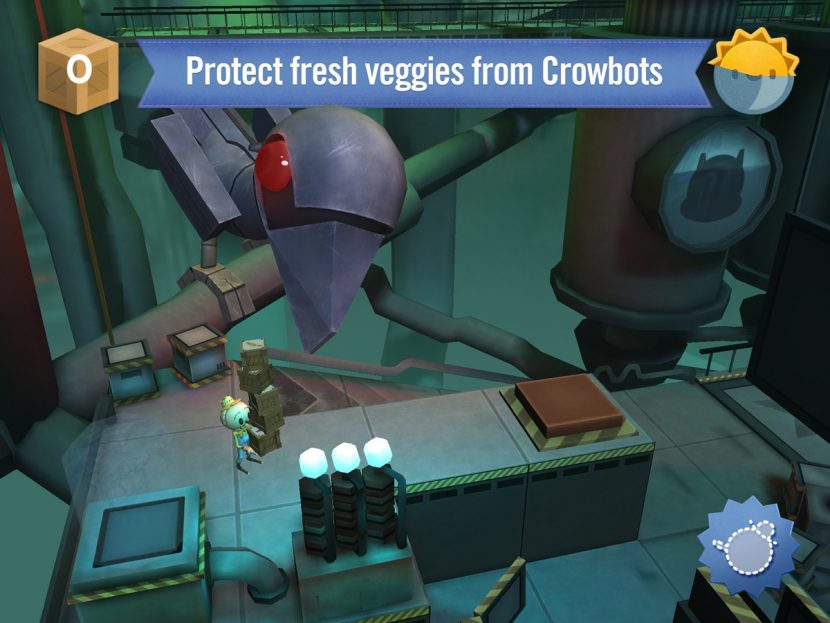
Fabian: We had intentions to repurpose the hero and other characters, but when we began to develop the game we realized the mechanics we wanted to use was that the camera had to be a little further back. We stylized their look as well, which I think is great because it brings its own aesthetic to the game and makes it live in its own world. The citizens look like they do in the film, and the crows and the scarecrow were more ‘game-designed’, but everything was informed from the style frames from the film.

AaAaghWERTJ$%! That was so good! The music, the art style, details like his hat swaying on the conveyor belt or the other scarecrows looking at him when the camera pulls back at the end… Loved it!
Pingback: How Moonbot Studios made 'The Scarecrow' - a chilling tale about the state of food production - wolfcrow